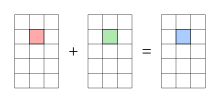Matrix addition
The matrix addition or matrix addition is in the mathematics an additive combination of two matrices of the same size. The result of a matrix addition is called the matrix sum , matrix sum or sum matrix and is obtained by adding the corresponding entries of the two output matrices component by component . The matrix addition is associative , commutative and, with the matrix multiplication, distributive .
The set of matrices of the same size and the matrix addition form an additive group , the neutral element of which is the zero matrix . The set of square matrices of the same size over a ring forms a ring with the matrix addition and the matrix multiplication. The set of matrices of the same size over a body forms a vector space with the matrix addition and the scalar multiplication .
definition
If a ring is and are as well as two matrices above , then the matrix sum becomes from and through
Are defined. The sum matrix is obtained by adding the corresponding entries of the two output matrices component by component. It is only defined for the case that the two starting matrices have the same size. The result matrix then also has this size.
example
The matrix sum of the two real (2 × 2) matrices
- and
results as
- .
properties
The matrix addition inherits the properties of the underlying ring. It is associative , ie for matrices applies
- .
and commutative , so
- .
Furthermore, the matrix addition is compatible with the multiplication of scalars , that is
- .
Together with the matrix multiplication , the distributive laws also apply
- and .
A sum of two matrices also applies to the transposed matrix
- .
The sum of two symmetrical matrices is therefore again symmetrical.
Algebraic structures
Matrices as a group
The set of fixed-size matrices forms an additive group with the matrix addition . The neutral element in this group is the zero matrix , where all entries are equal to the zero element in . Thus applies to all matrices
- .
The additively inverse element of a matrix is then the matrix
- ,
wherein the additive inverse element to in illustrating. The difference between two matrices is given by
- .
Die rings
The set of square matrices of fixed size forms a (non-commutative) ring with the matrix addition and the matrix multiplication . If the underlying ring is unitary , then the associated matrix ring is also unitary, the unit element being represented by the unit matrix.
The set of matrices of any fixed size with the matrix addition and the Hadamard product also forms a ring . If unitary, then this matrix ring also has a unit element, the unit matrix , in which all elements are equal to the unit element of the starting ring.
Die space
The set of matrices of any fixed size over a body forms a vector space with the matrix addition and the scalar multiplication . The standard basis for this matrix space consists of the set of standard matrices in which the entry at position is one and all other entries are zero. The matrix space therefore has the dimension .
If there is a matrix over the field of real or complex numbers and a matrix norm , then, by definition of a norm , the triangle inequality applies
- .
The norm of a matrix sum is therefore at most as large as the sum of the norms of the summands.
literature
- Michael Artin : Algebra . Springer, 1998, ISBN 3-7643-5938-2 .
- Charles E. Leiserson , Ronald L. Rivest , Clifford Stein: Algorithms - An Introduction . Oldenbourg, 2010, ISBN 3-486-59002-2 .
- Eberhard Zeidler (Hrsg.): Pocket book of mathematics . tape 1 . Springer, 2012, ISBN 978-3-8351-0123-4 .
Web links
- DA Suprunenko: Matrix . In: Michiel Hazewinkel (Ed.): Encyclopaedia of Mathematics . Springer-Verlag , Berlin 2002, ISBN 978-1-55608-010-4 (English, online ).
- Eric W. Weisstein : Matrix addition . In: MathWorld (English).
- djao: Matrix operations . In: PlanetMath . (English)







































